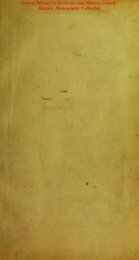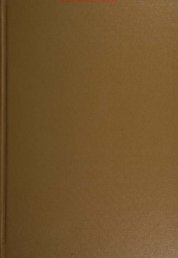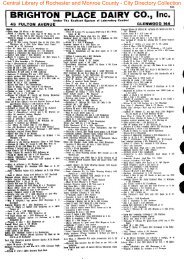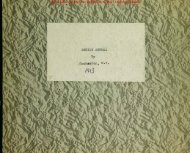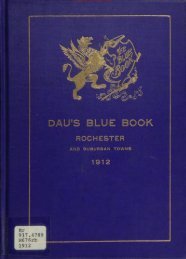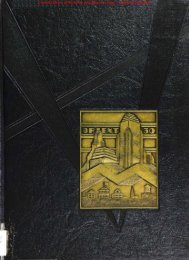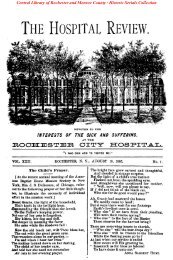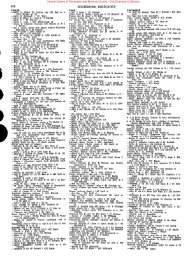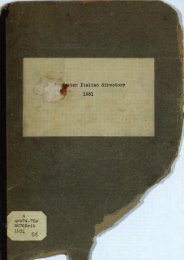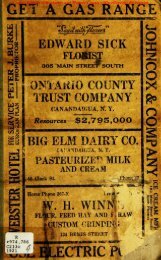The Farm Journal Illustrated Rural Directory of Monroe County, New ...
The Farm Journal Illustrated Rural Directory of Monroe County, New ...
The Farm Journal Illustrated Rural Directory of Monroe County, New ...
You also want an ePaper? Increase the reach of your titles
YUMPU automatically turns print PDFs into web optimized ePapers that Google loves.
Central Library <strong>of</strong> Rochester and <strong>Monroe</strong> <strong>County</strong> · <strong>County</strong> Directories Collection<br />
CLASSIFIED BUSINESS DIRECTORY<br />
<strong>of</strong> hot water, and dilute with about six<br />
gallons <strong>of</strong> cold water. This is a good<br />
application for aphis (lice) on trees or<br />
plants. For oyster-shell or scurvy scale<br />
use this spray in May or June or when<br />
the tiny scale lice are moving about on<br />
the bark.<br />
TOBACCO TEA.—Place five pounds <strong>of</strong><br />
tobacco stems in a water-tight vessel,<br />
and cover them with three gallons <strong>of</strong><br />
h»t water. Allow to stand several<br />
hours; dilute the liquor by adding about<br />
seven gallons <strong>of</strong> water. Strain and apply.<br />
Good for lice.<br />
» LIME-SULPHUR MIXTURE. — Slake<br />
twenty-two pounds <strong>of</strong> fresh lump lime<br />
in the vessel in which the mixture is to<br />
be boiled, using only enough water to<br />
cover the lime. Add seventeen pounds<br />
<strong>of</strong> sulphur (flowers or powdered), having<br />
previously mixed it in a paste with<br />
water. <strong>The</strong>n boil the mixture for about<br />
an hour in about ten gallons <strong>of</strong> water,<br />
using an iron but not a copper vessel.<br />
Next add enough more water to make,<br />
in all, fifty gallons. Strain through<br />
wire sieve or netting, and apply while<br />
mixture is still warm. A >gobd, highpressure<br />
pump is essential to satisfactory<br />
work. Coat every particle <strong>of</strong> the<br />
tree. This is the standard San Jose<br />
scale remedy, although some orchardists<br />
prefer to use the soluble oil sprays now<br />
on the market<br />
PYRETHRUM, OR PERSIAN INSECT POW-<br />
DER.—It may be dusted on with a powder<br />
bellows when the plants are wet;<br />
or one ounce <strong>of</strong> it may be steeped in<br />
one gallon <strong>of</strong> hot water, and sprayed on<br />
the plants at any time. It is <strong>of</strong>ten used<br />
on flowers, in greenhouses, on vegetables,<br />
etc<br />
BISULPHIDE OF CARBON.—This is used<br />
to kill weevils in beans and peas, etc.<br />
It comes in liquid form and may be had<br />
oi druggists. When exposed to the air<br />
it quickly vaporizes into a poisonous and<br />
exo'osive eas which is heavier than air<br />
Tobacco stems, tobacco dust, kainit,<br />
soot, freshly-slaked lime, dust, etc., are<br />
<strong>of</strong>ten used as insect preventives—in the<br />
soil around plants to keep away grubs,<br />
worms and maggots, or. dusted on to<br />
discourage the visits <strong>of</strong> cucumber bugs,<br />
etc. (Note.—<strong>The</strong> first four are excel<br />
lent fertilizers as well as insect preventives.)<br />
Crows and blackbirds frequently pull<br />
up planted corn. <strong>The</strong> best preventive<br />
is to tar the seed, as follows: Put the<br />
seed into a pail and pour on enough<br />
warm water to cover it. Add a teaspoonful<br />
<strong>of</strong> coal-tar to a peck, and stir<br />
welL Throw the seed out on a sieve<br />
or in a basket to drain, and then stir<br />
in a few handfuls <strong>of</strong> land plaster (gypsum),<br />
or air-slaked lime.<br />
A NEW FUNGICIDE.—Some orchardists<br />
are now using the following selfboiled<br />
lime-sulphur spray, instead <strong>of</strong><br />
Bordeaux, claiming that it is less liable<br />
to spot or burn fruit and foliage: Put<br />
eight pounds <strong>of</strong> unslaked lump lime in<br />
a barrel; add enough water to cover.<br />
When the lime begins to heat, throw in<br />
eight pounds <strong>of</strong> flowers <strong>of</strong> sulphur.<br />
Constantly stir andv gradually pour on<br />
more water until the lime is all slaked;<br />
then add the rest <strong>of</strong> the water to cool<br />
the mixture. About fifty gallons <strong>of</strong><br />
water, in all, are required. Strain.<br />
Two pounds <strong>of</strong> arsenate <strong>of</strong> lead may<br />
be added, if desired, to the finished<br />
mixture, which then becomes a combined<br />
fungicide and insecticide, and<br />
may be used in the same manner as<br />
advised for Bordeaux-arsenate <strong>of</strong> lead.<br />
(Special note.—<strong>The</strong> self-boiled mixture<br />
is not the same as the lime-sulphur<br />
advised for San Jose scale, which is<br />
too strong for trees in foliage.)<br />
If you do not care to bother with<br />
making spraying mixtures at home, they<br />
purchased, already prepared, <strong>of</strong><br />
v<br />
' / .<br />
exp.osivc gis * „ . ,., seedsmen. For only a few trees or<br />
and which will destroy all insect me.<br />
J<br />
(Caution.-Do not inhale the vapor, and plants, the extra cost <strong>of</strong> these factory<br />
allow no lights near.)<br />
mixtures is not great<br />
385



